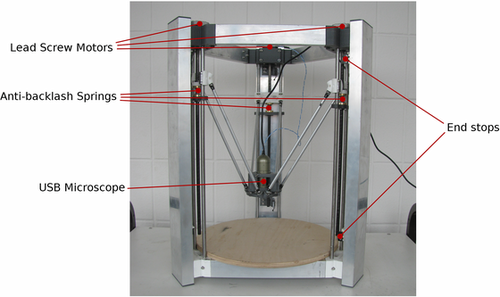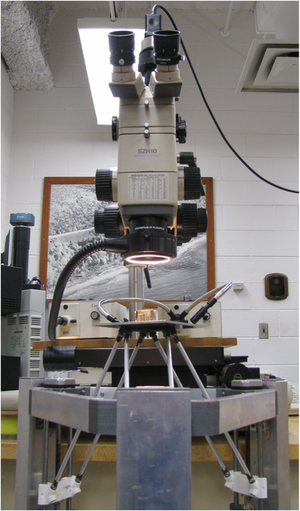J.M.Pearce (talk | contribs) m (→Source) |
J.M.Pearce (talk | contribs) |
||
| (2 intermediate revisions by the same user not shown) | |||
| Line 32: | Line 32: | ||
|- | |- | ||
|} | |} | ||
== Code for quick picture using Franklin== | |||
By Bas | |||
<nowiki> #!/usr/bin/python3 </nowiki> | |||
import websocketd | |||
p = websocketd.RPC('host.with.franklin:8000', tls = False) | |||
for y in range(10): | |||
for x in range(10): | |||
p.line_cb((x, y)) | |||
<nowiki> # Insert code for taking a picture here.</nowiki> | |||
==See also== | ==See also== | ||
Revision as of 11:57, 14 May 2018
Template:Statusboxtop Template:Status-design Template:Status-model Template:Status-prototype Template:Status-verified You can help Appropedia by contributing to the next step in this OSAT's status. Template:Boxbottom
Source

- Wijnen, B., Petersen, E. E., Hunt, E. J. and Pearce, J. M. (2016), Free and open-source automated 3-D microscope. Journal of Microscopy 264(2), 238-246. doi:10.1111/jmi.12433 free open access
- This project is derived from: MOST Delta RepRap and the MOST Athena RepRap To build the microscope follow the basic instructions for the Athena
- Open Source Software:Franklin
- Design information, BOM, etc.: https://osf.io/v2pwa/ (koios)
Abstract
Open-source technology not only has facilitated the expansion of the greater research community, but by lowering costs it has encouraged innovation and customizable design. The field of automated microscopy has continued to be a challenge in accessibility due the expense and inflexible, noninterchangeable stages. This paper presents a low-cost, open-source microscope 3-D stage. A RepRap 3-D printer was converted to an optical microscope equipped with a customized, 3-D printed holder for a USB microscope. Precision measurements were determined to have an average error of 10 μm at the maximum speed and 27 μm at the minimum recorded speed. Accuracy tests yielded an error of 0.15%. The machine is a true 3-D stage and thus able to operate with USB microscopes or conventional desktop microscopes. It is larger than all commercial alternatives, and is thus capable of high-depth images over unprecedented areas and complex geometries. The repeatability is below 2-D microscope stages, but testing shows that it is adequate for the majority of scientific applications. The open-source microscope stage costs less than 3–9% of the closest proprietary commercial stages. This extreme affordability vastly improves accessibility for 3-D microscopy throughout the world.
Lay description

The concept of open-source technology stems from the developmental model of accessibility and ease of use, enabling an environment of continual improvement and open communication. This approach has the potential to dramatically change many fields of study including that of microscope use in research settings. Automated microscopy is often a challenging and inaccessible field due to the cost and noninterchangeable stages, the flat plate on which samples are placed for analysis. This paper presents a low-cost, open-source microscope 3-D stage. A RepRap 3-D printer was converted to an optical microscope equipped with a customized, 3-D printed holder for a USB microscope. Precision measurements were determined to have an average error of 10μ at the maximum speed and 27μ at the minimum recorded speed. Accuracy tests yielded an error of 0.15%. The machine is a true 3-D stage and thus able to operate with USB microscopes or conventional desktop microscopes. Because it is larger than all current commercial alternative systems, it is capable of high depth images over unprecedented areas and complex geometries. The repeatability is below 2-D microscope stages, but testing shows that it is adequate for the majority of scientific applications. The open-source microscope stage costs less than 3% to 9% of the closest proprietary commercial stages. This extreme affordability vastly improves accessibility for 3-D microscopy throughout the world.
| How to Use the OS 3-D Microscope |
|---|
Error in widget YouTube: Unable to load template 'wiki:YouTube' |
Code for quick picture using Franklin
By Bas
#!/usr/bin/python3
import websocketd
p = websocketd.RPC('host.with.franklin:8000', tls = False)
for y in range(10):
for x in range(10):
p.line_cb((x, y))
# Insert code for taking a picture here.
See also
- Open-source 3-D Platform for Low-cost Scientific Instrument Ecosystem
- Open-source Lab
- Building research equipment with free, open-source hardware
- Open source science
- Open source optics
- Open source 3-D printing of OSAT
- Open-source hardware
- Open-source mobile water quality testing platform
- Open-source colorimeter





